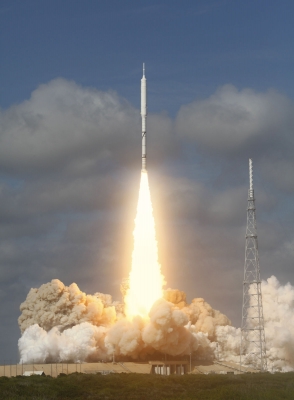
Every year the world sends satellites and spacecraft to space to improve communications on Earth or to explore planets and moons. But how are these heavy objects sent to space?
A rocket ride
We launch things into space by putting them onto rockets that carry tonnes of propellants (fuel). These propellants give the rocket enough energy to boost away from Earth’s surface. Because of Earth’s gravitational pull the heaviest and the largest satellites or spacecraft need the biggest of rockets with most propellant.
Action and reaction
We now know that we need a rocket to send objects to space, but how does a rocket lift off? The most important idea behind a rocket’s lift off is Issac Newton’s over 300-year-old law, which states that for every action there is an equal and opposite reaction.
If you have seen photos and videos of a rocket launch, you would not have missed seeing exhaust streaming from the bottom of the rocket. This exhaust is the flames, hot gases and smoke that come from burning the rockets propellants. This exhaust pushes out from a rocket’s engine down toward the ground. This is the action force. In response to this action, the rocket begins moving in the opposite direction, lifting off the ground. This is the reaction force.
Let’s keep moving
While the rocket will lift off due to the reactive force of the exhaust, Earth’s gravity will continue pulling it down. So how does the rocket continue moving upwards? When a rocket bums propellants and pushes out exhaust an upward force called thrust is created. To launch, the rocket needs enough propellants to create thrust that is greater than the force of the gravity pulling the rocket down. A rocket needs to speed up to at least 29,000 km/hr and fly above most of the atmosphere in a curved path around Earth. This will ensure that the gravity will not pull it back down.
Picture Credit : Google

